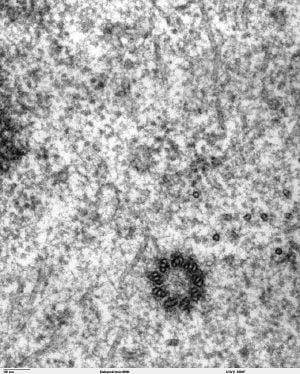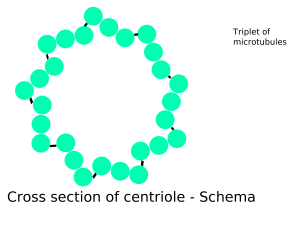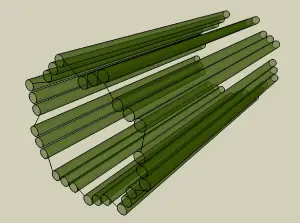Difference between revisions of "Centriole" - New World Encyclopedia
Rick Swarts (talk | contribs) |
Rick Swarts (talk | contribs) |
||
| Line 66: | Line 66: | ||
==References== | ==References== | ||
| + | * Alberts, B., D. Bray, J. Lewis, M. Raff, K. Roberts, and J. D. Watson. ''Molecular Biology of the Cell'', 2nd edition. New York: Garland Publishing, 1989. ISBN 0824036956. | ||
| + | |||
| + | * Alberts, B., A. Johnson, J. Lewis, M. Raff, K. Roberts, and P. Walter. 2002. ''Molecular Biology of the Cell'', 4th edition. New York: Garland Science. ISBN 0815332181. | ||
| + | |||
{{Reflist}} | {{Reflist}} | ||
Revision as of 11:13, 8 July 2008
A centriole is a barrel shaped organelle[1] found in most animal eukaryotic cells, though absent in higher plants and fungi.[2] The walls of each centriole are usually composed of nine triplets of microtubules (protein of the cytoskeleton). Deviations from this structure include Drosophila melanogaster embryos, with nine doublets, and Caenorhabditis elegans sperm cells and early embryos, with nine singlets.[3] [4] An associated pair of centrioles, arranged perpendicularly and surrounded by an amorphous mass of dense material (known as the Pericentriolar material) constitutes the compound structure known as the centrosome.[1]
Function
Cell division
Centrioles are involved in the organization of the mitotic spindle and in the completion of cytokinesis.[5] Centrioles were historically thought to be required for the formation of a mitotic spindle in animal cells. However, more recent experiments have demonstrated that cells whose centrioles have been removed via laser ablation can still undergo mitosis.[6] Additionally, mutant flies lacking centrioles can develop almost normally, although the adult flies lack flagella and cilia, a lack that underscores the requirement of centrioles for the formation of these organelles (see below).[7] Cells whose centrioles have been removed (either via laser ablation, or genetic manipulation) lack aster microtubules. These cells often fail to undergo proper asymmetric cell division, as the aster microtubules help to position the spindle within the cell.
Cellular organization
Centrioles are a very important part of centrosomes, which are involved in organizing microtubules in the cytoplasm.[8] [9]The position of the centriole determines the position of the nucleus and plays a crucial role in the spatial arrangement of cell organelles.
- In cell biology, the centrosome is an organelle that serves as the main microtubule organizing center (MTOC) of the animal cell as well as a regulator of cell-cycle progression. The centrosome is thought to have evolved only in the metazoan lineage of eukaryotic cells.[10] Fungi and plants use other MTOC structures to organize their microtubules.[11][12] Although the centrosome has a key role in efficient mitosis in animal cells, it is not necessary.[13]
Centrosomes are composed of two orthogonally arranged centrioles surrounded by an amorphous mass of pericentriolar material (PCM). The PCM contains proteins responsible for microtubule nucleation and anchoring[14] including γ-tubulin, pericentrin and ninein. Each centriole generally comprises nine triplet microtubule blades in a cartwheel structure as well as centrin, cenexin and tektin.[15]
Ciliogenesis
In organisms with flagella and cilia, the position of these organelles is determined by the mother centriole, which becomes the basal body. An inability of cells to use centrioles to make functional cilia and flagella has been linked to a number of genetic and developmental diseases. In particular, the inability of centrioles to properly migrate prior to ciliary assembly has recently been linked to Meckel-Gruber syndrome.
Animal development
Additionally, proper orientation of cilia via centriole positioning toward the posterior of embryonic node cells is critical for establishing left–right asymmetry during mammalian development.[8]
Structure of centrioles and mechanism of their duplication
Cells in G0 and G1 usually contain two complete centrioles. The older of the two centrioles in a pair is termed the mother centriole, whereas the younger is termed the daughter centriole. During the cell division cycle, a new centriole grows from the side of each of the existing "mother" centrioles. After centriole duplication, the two pairs of centrioles remain attached to each other in an orthogonal configuration until mitosis, when the mother and daughter centrioles separate in a manner dependent upon the enzyme separase[16].
The two centrioles in the centrosome are connected to each other unidentified by proteins. The mother centriole has radiating appendages at the distal end of its long axis and is attached to the daughter centriole at the other proximal end. Each daughter cell formed after cell division will inherit one of these pairs (one older and one newer centriole). Duplication of centrioles starts at the time of the G1/S transition and ends before the onset of mitosis.[5]
ReferencesISBN links support NWE through referral fees
- Alberts, B., D. Bray, J. Lewis, M. Raff, K. Roberts, and J. D. Watson. Molecular Biology of the Cell, 2nd edition. New York: Garland Publishing, 1989. ISBN 0824036956.
- Alberts, B., A. Johnson, J. Lewis, M. Raff, K. Roberts, and P. Walter. 2002. Molecular Biology of the Cell, 4th edition. New York: Garland Science. ISBN 0815332181.
- ↑ 1.0 1.1 B. Edde, J. Rossier, J.P. Le Caer, E. Desbruyeres, F. Gros & P. Denoulet (1990). Posttranslational glutamylation of alpha-tubulin. Science 247: 83–85.
- ↑ L.M. Quarmby & J.D.K. Parker (6 Jun 2005). Cilia and the cell cycle?. J. Cell Biol. 169 (5): 707–710.
- ↑ Marie Delattre and Pierre Gönczy, The arithmetic of centrosome biogenesis, Journal of Cell Science 117, 1619-1630 (2004)
- ↑ SAS-6 defines a protein family required for centrosome duplication in C. elegans and in human cells, Nature Cell Biology 7, 115 - 125 (2005)
- ↑ 5.0 5.1 Jeffrey L. Salisbury, Kelly M. Suino, Robert Busby, Margaret Springett; Centrin-2 Is Required for Centriole Duplication in Mammalian Cells; Current Biology, Volume 12, Issue 15, 6 August 2002, Pages 1287-1292; doi:10.1016/S0960-9822(02)01019-9
- ↑ La Terra S, English CN, Hergert P, McEwen BF, Sluder G, Khodjakov A.; The de novo centriole assembly pathway in HeLa cells: cell cycle progression and centriole assembly/maturation.; Journal of Cell Biology, Volume 168, Issue 5, 28 Feb 2005, Pages 713-22
- ↑ Basto R, Lau J, Vinogradova T, Gardiol A, Woods CG, Khodjakov A, Raff JW.; Flies without centrioles; Cell, Volume 125, Issue 7, 30 June 2006, Pages 1375-86
- ↑ 8.0 8.1 Jessica L. Feldman, Stefan Geimer, Wallace F. Marshall; The Mother Centriole Plays an Instructive Role in Defining Cell Geometry; PLoS Biol 5(6): e149 doi:10.1371/journal.pbio.0050149 (Creative Commons Attribution License)
- ↑ Beisson, J. and Wright M. (2003). Basal body/centriole assembly and continuity. Current Opinion in Cell Biology 15, 96-104.
- ↑ Bornens M, Azimzadeh J (2007). Origin and evolution of the centrosome. Adv. Exp. Med. Biol. 607: 119–29.
- ↑ Schmit AC (2002). Acentrosomal microtubule nucleation in higher plants. Int. Rev. Cytol. 220: 257–89.
- ↑ Jaspersen SL, Winey M (2004). The budding yeast spindle pol body: structure, duplication, and function. Annu. Rev. Cell Dev. Biol. 20: 1–28.
- ↑ Mahoney NM, Goshima G, Douglass AD, Vale RD (2006). Making microtubules and mitotic spindles in cells without functional centrosomes. Curr. Biol. 16 (6): 564–9.
- ↑ B. Edde, J. Rossier, J.P. Le Caer, E. Desbruyeres, F. Gros & P. Denoulet (1990). Posttranslational glutamylation of alpha-tubulin. Science 1990: 83–85.
- ↑ Rieder, CL, S Faruki and A Khodjakov (2001) TRENDS in Cell Biology 11 10:413-418.
- ↑ Tsou and Stearns (2006) Mechanism limiting centrosome duplication to once per cell cycle. Nature.442(7105):947-51.
| Organelles of the cell |
|---|
| Acrosome | Chloroplast | Cilium/Flagellum | Centriole | Endoplasmic reticulum | Golgi apparatus | Lysosome | Melanosome | Mitochondrion | Myofibril | Nucleus | Parenthesome | Peroxisome | Plastid | Ribosome | Vacuole | Vesicle |
Credits
New World Encyclopedia writers and editors rewrote and completed the Wikipedia article in accordance with New World Encyclopedia standards. This article abides by terms of the Creative Commons CC-by-sa 3.0 License (CC-by-sa), which may be used and disseminated with proper attribution. Credit is due under the terms of this license that can reference both the New World Encyclopedia contributors and the selfless volunteer contributors of the Wikimedia Foundation. To cite this article click here for a list of acceptable citing formats.The history of earlier contributions by wikipedians is accessible to researchers here:
The history of this article since it was imported to New World Encyclopedia:
Note: Some restrictions may apply to use of individual images which are separately licensed.


